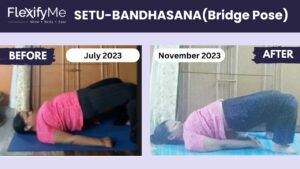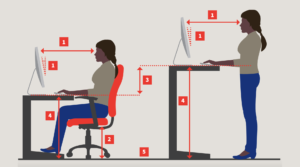The Secret to a Better Night’s Sleep: It’s All in Your Posture
Ever toss and turn all night, only to wake up feeling like you haven’t slept a wink? You’re not alone. Millions of people struggle with maintaining a good night’s sleep, often unaware of the simple yet powerful factor that can significantly impact their slumber: sleep posture.

Think of it like this: just as good posture benefits your physical health during the day, adopting the right sleeping position can do wonders for your overall well-being. From improving sleep quality to reducing pain and even boosting your mood, a good night’s rest starts with how you position your body.
The Link Between Sleep Posture and Your Health
Our sleep posture directly affects our spinal alignment, the natural curve of our spine. Imagine sleeping on your stomach with your neck cranked at an awkward angle – that constant strain can put undue stress on your spine and surrounding muscles. This translates to various aches and pains, including back pain, neck stiffness, and even headaches.

Research also suggests a connection between poor sleep posture and sleep-disordered breathing, where your breathing gets interrupted during sleep. This disruption can lead to fragmented sleep, leaving you feeling tired and foggy-brained throughout the day.
Finding the Sweet Spot for Sleep
The “best” sleep position is ultimately the one that feels most comfortable and allows you to maintain a neutral spinal alignment. However, some positions generally offer more benefits than others:
- Sleeping on your back: This position distributes your weight evenly and keeps your spine in a neutral state. Placing a pillow under your knees can provide additional support for your lower back.
- Sleeping on your side: This is also a good option, particularly if you experience back pain or sleep apnea. Choose a supportive pillow that fills the gap between your neck and shoulder.
Beyond Posture: Tips for a Restful Night
While finding the right sleep posture is crucial, incorporating other healthy sleep habits can further enhance your slumber:
- Consistency is key: Aim to go to bed and wake up around the same time each day, even on weekends.
- Unwind before bed: Create a relaxing bedtime routine with calming activities like reading or taking a warm bath.
- Optimize your sleep environment: Ensure your bedroom is cool, dark, and quiet.
Prioritizing a healthy sleep posture and implementing these additional tips can unlock the door to a better night’s sleep, leaving you feeling refreshed and ready to tackle the day.
Source: National Sleep Foundation:
Navigating the Night: Exploring Common Sleeping Positions and Their Impact
We all have our preferred slumber sanctuary, a specific posture that lulls us into a deep sleep. But have you ever considered how your sleeping position impacts your health? While comfort is crucial, different sleeping positions can exert varying influences on your spinal alignment and pressure points, potentially affecting your well-being. Let’s delve into the three most common sleeping positions and their potential consequences:
1. Back Sleeping: The Champion of Spinal Neutrality
Often hailed as the “golden standard” of sleep positions, back sleeping promotes neutral spinal alignment. Lying flat on your back with a pillow supporting your head and perhaps another under your knees helps distribute your weight evenly, minimizing pressure points. This position can be particularly beneficial for those experiencing back pain or sleep apnea, as it keeps the airway open.
However, back sleeping isn’t without its drawbacks. Some individuals might experience snoring in this position, and those with acid reflux may find their symptoms worsen.
Source: Cleveland Clinic: Sleeping positions: Tips to wake up pain-free with Andrew Bang, DC:

2. Side Sleeping: A Comfortable Compromise
Side sleeping is the most popular position, offering a good balance between comfort and support. It generally maintains a relatively neutral spine and minimizes pressure on the organs. Additionally, side sleeping may be helpful for individuals with sleep apnea and heartburn.
However, side sleeping can put strain on the shoulders and hips, especially if your mattress isn’t supportive enough. To mitigate this, placing a pillow between your knees can help align your spine and alleviate pressure.
Source: Spine Universe: Best Sleeping Positions for Back Pain Relief:
3. Stomach Sleeping: The Potential Pain Culprit
While some people find stomach sleeping comfortable, it’s generally considered the least recommended position from a spinal health perspective. Sleeping on your stomach forces your neck to hyperextend, potentially leading to neck pain and stiffness. Additionally, this position can put undue strain on your lower back, causing or aggravating back pain.
If you’re a dedicated stomach sleeper, consider placing a flat pillow under your stomach and avoiding excessively thick pillows under your head. However, transitioning to a different position, like back or side sleeping, is often recommended for optimal spinal alignment and pain reduction.
Remember: The “best” sleep position is ultimately the one that allows you to sleep comfortably while maintaining a neutral spine. Experiment with different positions and find what works best for you. If you experience persistent pain or discomfort, consult a healthcare professional for personalized guidance.
Unlock a Good Night’s Sleep: Strategies for Improving Sleep Posture (400 words)
Ever toss and turn all night, only to wake up feeling like you wrestled a bear? While numerous factors can contribute to restless sleep, one often-overlooked culprit is sleep posture. The way you position your body while snoozing can significantly impact your sleep quality and even contribute to pain.
Fortunately, there are practical strategies you can implement to improve your sleep posture, regardless of your preferred sleeping position:
Back Sleepers:
- Invest in a supportive mattress: A mattress that conforms to your natural curves is crucial for maintaining proper spinal alignment. Opt for a medium-firm mattress that provides adequate support without being excessively hard.
- Choose the right pillow: A pillow with a moderate loft (height) that cradles your head and neck is key. Avoid overly thick pillows that force your neck into an unnatural position.
- Embrace the knee pillow: Placing a pillow under your knees can help maintain your lower back’s natural curve and prevent strain.
Side Sleepers:
- Select a supportive pillow: Similar to back sleepers, side sleepers need a pillow that fills the gap between their neck and shoulder. Opt for a slightly thicker pillow compared to back sleepers.
- Hug a body pillow: This can provide additional support and help maintain spinal alignment, especially for individuals who tend to twist and turn throughout the night.
- Mind your mattress firmness: Like back sleepers, a medium-firm mattress is generally recommended for side sleepers to provide adequate support without putting undue pressure on your hips and shoulders.
Stomach Sleepers (While not recommended):
- Consider transitioning to a different position: Due to the strain it places on your neck and back, stomach sleeping is generally discouraged. If you’re struggling to transition, try side sleeping with a body pillow for additional support.
- Opt for a thin pillow: A very thin pillow, or even no pillow at all, can help minimize neck hyperextension in this position.
General Tips for All Sleepers:
- Practice good sleep hygiene: Establish a consistent sleep schedule, create a relaxing bedtime routine, and optimize your sleep environment by ensuring it’s cool, dark, and quiet.
- Incorporate relaxation techniques: Engaging in activities like deep breathing or meditation before bed can help ease your mind and prepare your body for sleep.
- Listen to your body: Pay attention to how you feel upon waking up. If you experience persistent pain or discomfort, consult a healthcare professional for personalized guidance.
Remember, improving your sleep posture takes time and experimentation. By incorporating these strategies and tailoring them to your individual needs, you can pave the way for a more comfortable, pain-free, and ultimately, more restful sleep.
Taming the Nighttime Tussle: Overcoming Common Sleep Posture Challenges
We all dream of a good night’s sleep, but let’s be honest, achieving perfect posture throughout the night can feel like wrestling a pillow monster. Many of us face common sleep posture roadblocks that lead to a restless night and a grumpy morning. These challenges can manifest as restless sleep, frequent waking up, muscle tension, snoring, and even sleep apnea.
Challenge #1: The Restless Rumble:
If you find yourself constantly rearranging your bedsheets like a human burrito, it might be due to an uncomfortable sleep environment or an unsupportive mattress. Consider investing in a new mattress that offers the right amount of firmness and a pillow that cradles your head and neck just right. You can also try relaxation techniques like deep breathing or meditation before bed to quiet your mind and lull yourself into a peaceful slumber.
Challenge #2: The Muscle Matchmaker:
Waking up feeling like you went ten rounds with a heavyweight champion? Poor sleep posture could be the culprit. Experiment with different sleeping positions and pillows to find the perfect match for your body. Side sleepers can benefit from a body pillow for extra support, while back sleepers might find relief with a pillow under their knees to keep their spine aligned.
Challenge #3: The Snoring Symphony (and Sleep Apnea Solo):
While not always directly linked to sleep position, specific postures like sleeping on your back can worsen snoring and even contribute to sleep apnea. If you’re a chronic snorer or suspect sleep apnea, seeking professional help is crucial. A healthcare professional can diagnose the issue and recommend strategies, which may include adjusting your sleep position or suggesting a CPAP machine for managing sleep apnea.
Remember, there’s no magic bullet for sleep posture. Finding what works best for you is key, prioritizing both spinal alignment and comfort. However, if you’re still struggling to conquer the nighttime battle despite these tips, don’t hesitate to consult a healthcare professional. They can offer personalized advice and address any underlying medical conditions affecting your sleep quality.
Additional Resources:
- Mayo Clinic: What’s the best sleeping position? Mayo Clinic:
- National Institute of Neurological Disorders and Stroke: Sleep Apnea Information Page
By acknowledging these challenges and taking proactive steps to address them, you can finally win the battle for a good night’s sleep and wake up feeling refreshed and ready to conquer the day!
Sleep Tight, Live Bright: Conquering the Sleep Posture Puzzle!
Phew! We’ve delved deep into the world of sleep posture, uncovering its surprising impact on our daily lives. Remember, sleep isn’t just about catching those precious Zzz’s; it’s about quality slumber that fuels our mind, body, and spirit. By prioritizing healthy sleep habits, including good sleep posture, we unlock a treasure trove of benefits:
- Say goodbye to backaches: Say hello to a pain-free morning! Good sleep posture can help alleviate back pain, keeping you feeling limber and ready to tackle the day.
- Sharpen your mind: A good night’s sleep, facilitated by optimal posture, can boost your memory, focus, and overall brainpower. Think of it as a supercharge for your cognitive abilities!
- Energy levels that soar: Waking up feeling refreshed, thanks to good sleep posture, translates to having the energy to conquer your day. No more hitting the snooze button repeatedly!
Remember, the key to unlocking the power of good sleep posture is finding your personal sweet spot. Experiment with different positions, pillows, and mattresses, and prioritize spinal alignment for ultimate comfort and support. While we haven’t mentioned specific products or services, resources like FlexifyMe (or similar platforms) can offer personalized guidance on sleep posture and back pain management, if needed.
Most importantly, listen to your body and don’t hesitate to seek professional help. A healthcare professional can provide personalized recommendations and address any underlying medical conditions affecting your sleep quality.By prioritizing sleep hygiene and taking control of your sleep posture, you’re investing in a healthier, happier, and more vibrant you. So, put on your PJs, climb into your sleep haven, and remember, sleep tight, live bright!


